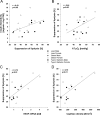Reduced oxygenation in human obese adipose tissue is associated with impaired insulin suppression of lipolysis
- PMID: 20466783
- PMCID: PMC2913036
- DOI: 10.1210/jc.2009-2377
Reduced oxygenation in human obese adipose tissue is associated with impaired insulin suppression of lipolysis
Abstract
Context: Adipose tissue in obese individuals is characterized by reduced capillary density and reduced oxygenation.
Objective: Our objective was to test whether hypoxia is associated with reduced antilipolytic effect of insulin.
Participants, design, and setting: Twenty-one lean and obese individuals participated in this cross-sectional study at a university-based clinical research center.
Intervention: In all subjects, in situ adipose tissue (AT) oxygenation [AT oxygen partial pressure (ATpO2)] was measured with a Clark electrode, insulin sensitivity as well as basal and insulin-suppressed lipolysis (continuous infusion of (2H5)glycerol) were measured during a euglycemic-hyperinsulinemic clamp, and abdominal sc AT biopsies were collected to assess fat cell size (Coulter counting of osmium-fixed cells), capillary density (by staining of histological sections), and gene expression (by quantitative RT-PCR).
Main outcome measure: In situ ATpO2 was evaluated.
Results: The ability of insulin to suppress lipolysis (percent) was positively correlated with insulin sensitivity (r=0.43; P<0.05), ATpO2 (r=0.44; P<0.05), vascular endothelial growth factor mRNA (r=0.73; P<0.01), and capillary density (r=0.75; P<0.01).
Conclusion: These results indicate that low capillary density and ATpO2 in AT are potentially upstream causes of AT dysfunction.
Trial registration: ClinicalTrials.gov NCT00704197.
Figures

References
-
- DeFronzo RA, Bonadonna RC, Ferrannini E 1992 Pathogenesis of NIDDM. A balanced overview. Diabetes Care 15:318–368 - PubMed
-
- Trayhurn P, Wood IS 2004 Adipokines: inflammation and the pleiotropic role of white adipose tissue. Br J Nutr 92:347–355 - PubMed
-
- Hosogai N, Fukuhara A, Oshima K, Miyata Y, Tanaka S, Segawa K, Furukawa S, Tochino Y, Komuro R, Matsuda M, Shimomura I 2007 Adipose tissue hypoxia in obesity and its impact on adipocytokine dysregulation. Diabetes 56:901–911 - PubMed

